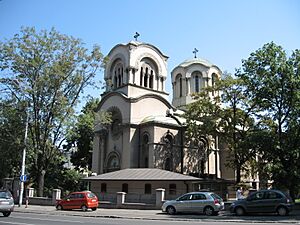Jelisaveta Načić facts for kids
Jelisaveta Načić (born December 31, 1878, in Belgrade – died June 6, 1955, in Dubrovnik) was a very important Serbian architect. She is remembered as a pioneer. She inspired many women to work in jobs that were usually only for men before. She was not only the first woman to graduate in architecture in Belgrade, but also the first female architect in all of Serbia!
Contents
Her Early Life and Education
Jelisaveta was born in Belgrade. She finished school with excellent grades in 1896. She then went to study architecture at the University of Belgrade's School of Architecture. At that time, many people thought women should not be architects. But Jelisaveta didn't let that stop her!
At just 22 years old, she became the first woman to graduate from the Faculty of Engineering. After graduating, she wanted to work for the Ministry of Construction. However, she could not become a full official there. This was because they required military service, which women could not do.
Becoming Belgrade's First Female Architect
Even though she couldn't join the Ministry, Jelisaveta found a way. She got a job as an architect with the Municipality of Belgrade. This made her the city's first chief architect! She was now in charge of many building projects in Belgrade.
Her Amazing Buildings and Designs
Jelisaveta Načić designed many important buildings. In 1903, she designed the Little Staircase in Belgrade's Kalemegdan Park. This is a beautiful part of the city.
Her most famous work is a school building she finished in 1906. It is now known as the Kralj Petar I (King Peter I) elementary school. It is known for its good design.
She also designed churches. These include the Alexander Nevsky Church (1929) in Belgrade. This church has a special style called Moravian. She also designed a smaller church in Kosovo.
Jelisaveta designed a hospital too, but it was sadly destroyed during the Second World War. Many of her other buildings are still standing today. She designed different types of homes, from apartments to unique private houses. Some of these houses have special design elements. These include Art Nouveau or Neo-Renaissance styles. She also designed the very first collective housing building for workers in the Balkan region.
Challenges and Later Life
During the First World War, Jelisaveta was held in a camp in Hungary. This sad event brought her career as an architect to an end. She had worked for about 16 years.
After the war, Načić moved to Dubrovnik. She went there with her husband, Luka Lukai, whom she had met in the camp. She was given a special state pension for all her life's achievements. Jelisaveta Načić passed away in Dubrovnik in 1955. She left behind a legacy of beautiful buildings and showed that women could achieve great things in any profession.
See also
 In Spanish: Jelisaveta Načić para niños
In Spanish: Jelisaveta Načić para niños


